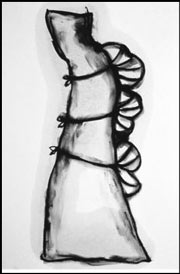SPLENDORFORM
Henry Art Gallery, UW campus, 543-2280 11 a.m.-5 p.m. Tues.-Sun; 11 a.m.-8 p.m. Thurs. ends Nov. 10
“She kept getting bigger. She demanded to be bigger.”
Elizabeth Jameson is talking about her sculpture Sweet Glow, the centerpiece of her new exhibition at the Henry. The show, titled “splendorform,” also features Jameson’s drawings, a video of one of her performance pieces, and vintage undergarments she and assistant curator Robin Held selected from the Henry’s costume collection.
Though “splendorform” may be a bit too clever for its own good, it shines with the unforgettable light of Sweet Glow. The piece drew an audible stir from members of the media assembled for a preview (who had just been lulled into a state of semisomnolence by a presentation on “The Photographic Impulse,” which also opened last week at the Henry).
The basic shape of the sculpture is taken from an 18th-century court dress, but the proportions have been wildly distorted. Roughly life-size in height and depth, Sweet Glow stretches out an alarming 32 feet in width. Built on a framework of Plexiglas, plywood, and canvas, the sculpture is entirely covered with rock candy and lit from within like a Chinese lantern. The illuminated texture of the sugary, crystalline covering is both hypnotically beautiful and creepy as hell, due in part to its sheer, toxic quantity.
It’s not surprising that Jameson felt the sculpture was making demands of her; for it—or “she,” as the artist prefers—does have a distinct personality: fussy, corrupt, aristocratic, and possessed of an infinite need for attention. I found it oppressive to be in the long, narrow room where Sweet Glow holds court like some demented queen, as if I, too, might fall under its dominion.
Though upstaged by the spectacle of Sweet Glow, the rest of Jameson’s work in “splendorform” is also very strong. Her drawings are spare and elegant renderings of anonymous figures wearing a variety of absurd garments, including dresses equipped with stairs, antique firefighter’s masks, and bespoke haz-mat suits. The drawings explore one of the artist’s favorite themes—the way we use clothing to insulate ourselves from fear. In Jameson’s work, physical and psychological fear meld into each other; the clothes seem designed to protect against both chemical spills and social anxiety.
Because Jameson’s work is informed by research on historical costumes, and the Henry has an extensive costume collection, it must have seemed a natural move to juxtapose her artwork with some of the period garments that have inspired her. It’s a clever idea but not necessarily a good one. Part of the power of her work, especially the drawings, comes from its nonspecificity. Jameson depicts no particular era nor any discernible narrative. Her images are like graphic dispatches from the unconscious—Freudian cave drawings. Certainly themes exist, but it’s the mysterious open-ended quality of the work that draws the viewer back again and again. Historical garments tie this otherwise wonderfully elusive artwork to definite times and places.
The inclusion of the garments also creates the danger that the art will be taken merely as a critique of the changing standards of beauty or an attack on the beastly things society forces women to do to feel attractive. Such a literal and schematic point of view does a disservice to these strange, deep images.









